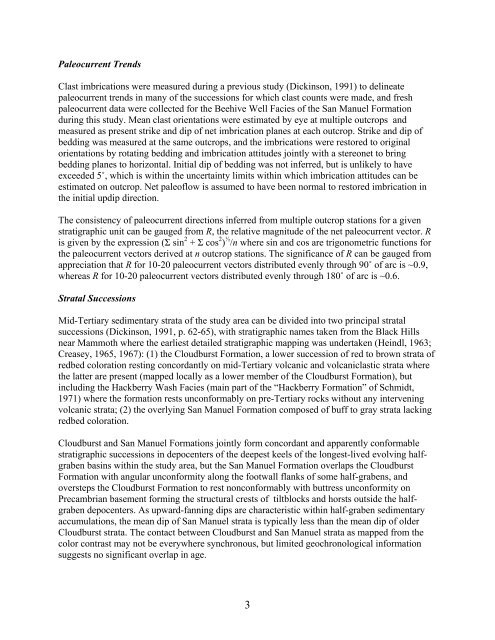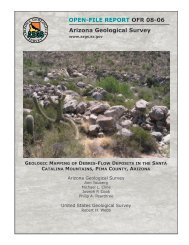Conglomerate Clast Counts in Oligocene-Miocene Strata North
Conglomerate Clast Counts in Oligocene-Miocene Strata North
Conglomerate Clast Counts in Oligocene-Miocene Strata North
Create successful ePaper yourself
Turn your PDF publications into a flip-book with our unique Google optimized e-Paper software.
Paleocurrent Trends<br />
<strong>Clast</strong> imbrications were measured dur<strong>in</strong>g a previous study (Dick<strong>in</strong>son, 1991) to del<strong>in</strong>eate<br />
paleocurrent trends <strong>in</strong> many of the successions for which clast counts were made, and fresh<br />
paleocurrent data were collected for the Beehive Well Facies of the San Manuel Formation<br />
dur<strong>in</strong>g this study. Mean clast orientations were estimated by eye at multiple outcrops and<br />
measured as present strike and dip of net imbrication planes at each outcrop. Strike and dip of<br />
bedd<strong>in</strong>g was measured at the same outcrops, and the imbrications were restored to orig<strong>in</strong>al<br />
orientations by rotat<strong>in</strong>g bedd<strong>in</strong>g and imbrication attitudes jo<strong>in</strong>tly with a stereonet to br<strong>in</strong>g<br />
bedd<strong>in</strong>g planes to horizontal. Initial dip of bedd<strong>in</strong>g was not <strong>in</strong>ferred, but is unlikely to have<br />
exceeded 5˚, which is with<strong>in</strong> the uncerta<strong>in</strong>ty limits with<strong>in</strong> which imbrication attitudes can be<br />
estimated on outcrop. Net paleoflow is assumed to have been normal to restored imbrication <strong>in</strong><br />
the <strong>in</strong>itial updip direction.<br />
The consistency of paleocurrent directions <strong>in</strong>ferred from multiple outcrop stations for a given<br />
stratigraphic unit can be gauged from R, the relative magnitude of the net paleocurrent vector. R<br />
is given by the expression (Σ s<strong>in</strong> 2 + Σ cos 2 ) ½ /n where s<strong>in</strong> and cos are trigonometric functions for<br />
the paleocurrent vectors derived at n outcrop stations. The significance of R can be gauged from<br />
appreciation that R for 10-20 paleocurrent vectors distributed evenly through 90˚ of arc is ~0.9,<br />
whereas R for 10-20 paleocurrent vectors distributed evenly through 180˚ of arc is ~0.6.<br />
<strong>Strata</strong>l Successions<br />
Mid-Tertiary sedimentary strata of the study area can be divided <strong>in</strong>to two pr<strong>in</strong>cipal stratal<br />
successions (Dick<strong>in</strong>son, 1991, p. 62-65), with stratigraphic names taken from the Black Hills<br />
near Mammoth where the earliest detailed stratigraphic mapp<strong>in</strong>g was undertaken (He<strong>in</strong>dl, 1963;<br />
Creasey, 1965, 1967): (1) the Cloudburst Formation, a lower succession of red to brown strata of<br />
redbed coloration rest<strong>in</strong>g concordantly on mid-Tertiary volcanic and volcaniclastic strata where<br />
the latter are present (mapped locally as a lower member of the Cloudburst Formation), but<br />
<strong>in</strong>clud<strong>in</strong>g the Hackberry Wash Facies (ma<strong>in</strong> part of the “Hackberry Formation” of Schmidt,<br />
1971) where the formation rests unconformably on pre-Tertiary rocks without any <strong>in</strong>terven<strong>in</strong>g<br />
volcanic strata; (2) the overly<strong>in</strong>g San Manuel Formation composed of buff to gray strata lack<strong>in</strong>g<br />
redbed coloration.<br />
Cloudburst and San Manuel Formations jo<strong>in</strong>tly form concordant and apparently conformable<br />
stratigraphic successions <strong>in</strong> depocenters of the deepest keels of the longest-lived evolv<strong>in</strong>g halfgraben<br />
bas<strong>in</strong>s with<strong>in</strong> the study area, but the San Manuel Formation overlaps the Cloudburst<br />
Formation with angular unconformity along the footwall flanks of some half-grabens, and<br />
oversteps the Cloudburst Formation to rest nonconformably with buttress unconformity on<br />
Precambrian basement form<strong>in</strong>g the structural crests of tiltblocks and horsts outside the halfgraben<br />
depocenters. As upward-fann<strong>in</strong>g dips are characteristic with<strong>in</strong> half-graben sedimentary<br />
accumulations, the mean dip of San Manuel strata is typically less than the mean dip of older<br />
Cloudburst strata. The contact between Cloudburst and San Manuel strata as mapped from the<br />
color contrast may not be everywhere synchronous, but limited geochronological <strong>in</strong>formation<br />
suggests no significant overlap <strong>in</strong> age.<br />
3

















